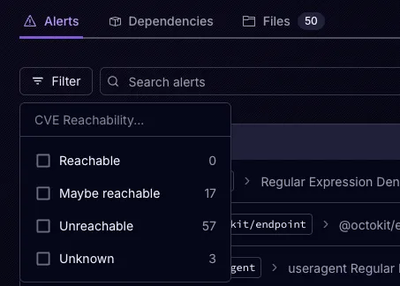
Product
Introducing License Overlays: Smarter License Management for Real-World Code
Customize license detection with Socket’s new license overlays: gain control, reduce noise, and handle edge cases with precision.
react-chartkick
Advanced tools
Create beautiful JavaScript charts with one line of React
Supports Chart.js, Google Charts, and Highcharts
Run
npm install react-chartkick chart.js
And add
import { LineChart, PieChart } from 'react-chartkick'
import 'chartkick/chart.js'
This sets up Chartkick with Chart.js. For other charting libraries, see detailed instructions.
Line chart
<LineChart data={{"2025-01-01": 11, "2025-01-02": 6}} />
Pie chart
<PieChart data={[["Blueberry", 44], ["Strawberry", 23]]} />
Column chart
<ColumnChart data={[["Sun", 32], ["Mon", 46], ["Tue", 28]]} />
Bar chart
<BarChart data={[["Work", 32], ["Play", 1492]]} />
Area chart
<AreaChart data={{"2025-01-01": 11, "2025-01-02": 6}} />
Scatter chart
<ScatterChart data={[[174.0, 80.0], [176.5, 82.3]]} xtitle="Size" ytitle="Population" />
Geo chart - Google Charts
<GeoChart data={[["United States", 44], ["Germany", 23], ["Brazil", 22]]} />
Timeline - Google Charts
<Timeline data={[["Washington", "1789-04-29", "1797-03-03"], ["Adams", "1797-03-03", "1801-03-03"]]} />
Multiple series
data = [
{name: "Workout", data: {"2025-01-01": 3, "2025-01-02": 4}},
{name: "Call parents", data: {"2025-01-01": 5, "2025-01-02": 3}}
];
and
<LineChart data={data} />
Data can be an array, object, callback, or URL.
<LineChart data={[["2025-01-01", 2], ["2025-01-02", 3]]} />
<LineChart data={{"2025-01-01": 2, "2025-01-02": 3}} />
function fetchData(success, fail) {
success({"2025-01-01": 2, "2025-01-02": 3})
// or fail("Data not available")
}
and
<LineChart data={fetchData} />
Make your pages load super fast and stop worrying about timeouts. Give each chart its own endpoint.
<LineChart data="/stocks" />
Id, width, and height
<LineChart id="users-chart" width="800px" height="500px" />
Min and max values
<LineChart min={1000} max={5000} />
min defaults to 0 for charts with non-negative values. Use null to let the charting library decide.
Min and max for x-axis - Chart.js
<LineChart xmin="2025-01-01" xmax="2025-02-01" />
Colors
<LineChart colors={["#b00", "#666"]} />
Stacked columns or bars
<ColumnChart stacked={true} />
Discrete axis
<LineChart discrete={true} />
Label (for single series)
<LineChart label="Value" />
Axis titles
<LineChart xtitle="Time" ytitle="Population" />
Straight lines between points instead of a curve
<LineChart curve={false} />
Show or hide legend
<LineChart legend={true} />
Specify legend position
<LineChart legend="bottom" />
Donut chart
<PieChart donut={true} />
Prefix, useful for currency - Chart.js, Highcharts
<LineChart prefix="$" />
Suffix, useful for percentages - Chart.js, Highcharts
<LineChart suffix="%" />
Set a thousands separator - Chart.js, Highcharts
<LineChart thousands="," />
Set a decimal separator - Chart.js, Highcharts
<LineChart decimal="," />
Set significant digits - Chart.js, Highcharts
<LineChart precision={3} />
Set rounding - Chart.js, Highcharts
<LineChart round={2} />
Show insignificant zeros, useful for currency - Chart.js, Highcharts
<LineChart round={2} zeros={true} />
Friendly byte sizes - Chart.js
<LineChart bytes={true} />
Specify the message when the chart is loading
<LineChart loading="Loading..." />
Specify the message when data is empty
<LineChart empty="No data" />
Refresh data from a remote source every n seconds
<LineChart refresh={60} />
You can pass options directly to the charting library with:
<LineChart library={{backgroundColor: "#eee"}} />
See the documentation for Google Charts, Highcharts, and Chart.js for more info.
To customize datasets in Chart.js, use:
<LineChart dataset={{borderWidth: 10}} />
You can pass this option to individual series as well.
To set options for all of your charts, use:
Chartkick.options = {
colors: ["#b00", "#666"]
}
You can pass a few options with a series:
namedatacolordataset - Chart.js onlypoints - Chart.js onlycurve - Chart.js onlyChart.js only
Give users the ability to download charts. It all happens in the browser - no server-side code needed.
<LineChart download={true} />
Set the filename
<LineChart download="boom" />
Note: Safari will open the image in a new window instead of downloading.
Set the background color
<LineChart download={{background: "#fff"}} />
Run
npm install react-chartkick chart.js
And add
import { LineChart, PieChart } from 'react-chartkick'
import 'chartkick/chart.js'
Run
npm install react-chartkick
And add
import Chartkick, { LineChart, PieChart } from 'react-chartkick'
And include on the page
<script src="https://www.gstatic.com/charts/loader.js"></script>
To specify a language or Google Maps API key, use:
Chartkick.configure({language: "de", mapsApiKey: "..."})
Run
npm install react-chartkick highcharts
And add
import { LineChart, PieChart } from 'react-chartkick'
import 'chartkick/highcharts'
Include the charting library and the Chartkick library
<script src="https://unpkg.com/chart.js@4.4.6/dist/chart.umd.js"></script>
<script src="https://unpkg.com/chartjs-adapter-date-fns@3.0.0/dist/chartjs-adapter-date-fns.bundle.js"></script>
<script src="https://unpkg.com/chartkick@5.0.1"></script>
<script src="https://unpkg.com/react-chartkick@0.5.4"></script>
Charts are prefixed with ReactChartkick, like ReactChartkick.LineChart.
If more than one charting library is loaded, choose between them with:
<LineChart adapter="google" />
Options are google, highcharts, and chartjs
View the changelog
Everyone is encouraged to help improve this project. Here are a few ways you can help:
To get started with development, run:
git clone https://github.com/ankane/react-chartkick.git
cd react-chartkick
npm install
npm run build
0.5.4 (2024-11-15)
FAQs
Create beautiful JavaScript charts with one line of React
The npm package react-chartkick receives a total of 5,798 weekly downloads. As such, react-chartkick popularity was classified as popular.
We found that react-chartkick demonstrated a healthy version release cadence and project activity because the last version was released less than a year ago. It has 0 open source maintainers collaborating on the project.
Did you know?

Socket for GitHub automatically highlights issues in each pull request and monitors the health of all your open source dependencies. Discover the contents of your packages and block harmful activity before you install or update your dependencies.

Product
Customize license detection with Socket’s new license overlays: gain control, reduce noise, and handle edge cases with precision.

Product
Socket now supports Rust and Cargo, offering package search for all users and experimental SBOM generation for enterprise projects.

Product
Socket’s precomputed reachability slashes false positives by flagging up to 80% of vulnerabilities as irrelevant, with no setup and instant results.